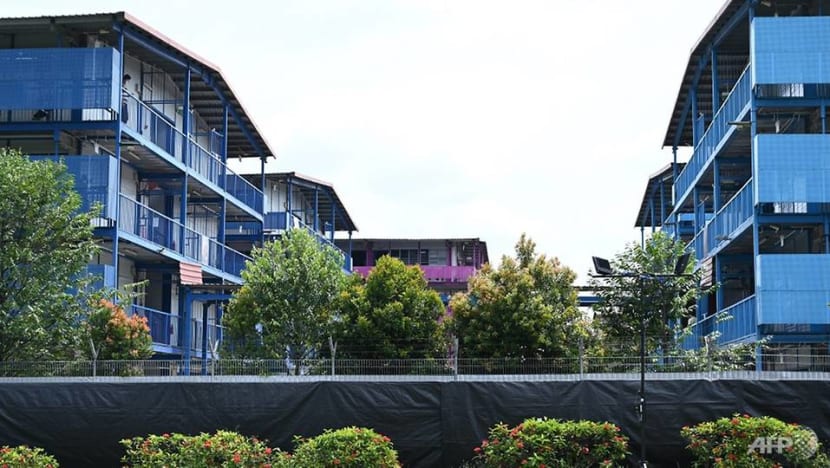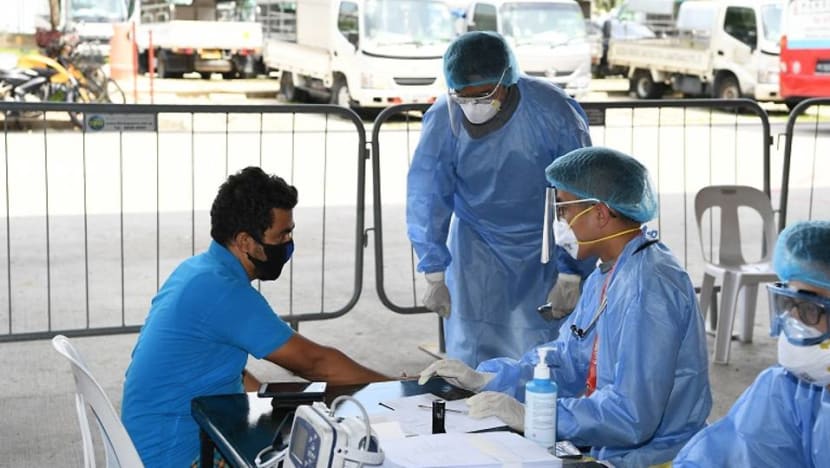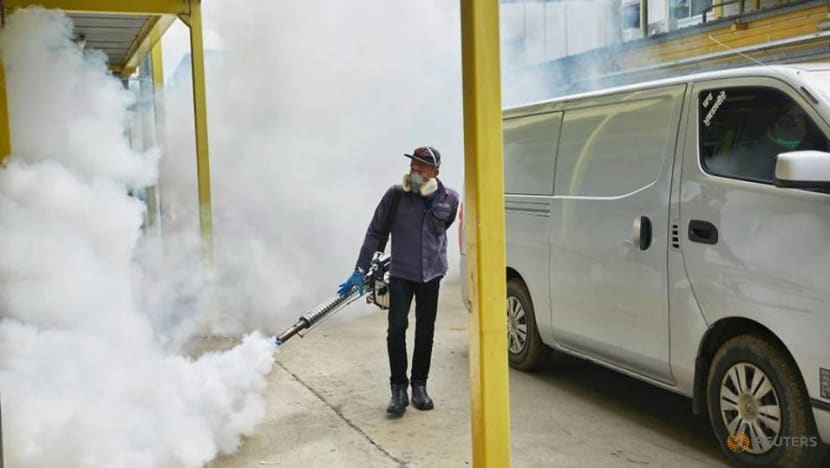No new cases linked to Singapore's biggest COVID-19 cluster for first time since Apr 1
The COVID-19 cluster at the S11 dormitory @ Punggol grew to more than 2,000 cases in less than a month.

Foreign workers stand along the corridor of their rooms in the S11 Dormitory @ Punggol in Singapore on Apr 6, 2020. (Photo: AFP/Roslan Rahman)
SINGAPORE: No new COVID-19 cases were linked to the cluster at the S11 @ Punggol foreign worker dormitory for the first time since Apr 1, according to the Ministry of Health’s (MOH) update of daily figures on Sunday (May 10).
The cluster – the largest in Singapore, with 2,545 cases as of Sunday – was among the first to be identified at dormitories.
Since then, more than 20,000 cases have been linked to dormitories across the country, forming nearly 90 per cent of COVID-19 cases in Singapore.
READ: COVID-19: Why 3 positive cases who died from heart issues were not added to Singapore’s official death toll
HOW THE S11 CLUSTER GREW TO SINGAPORE’S BIGGEST
The first two linked patients – Cases 826 and 829 – tested positive for the coronavirus on Mar 28.
Case 826, the first in the cluster, was a 48-year-old Bangladeshi national and long-term pass holder who was admitted to Sengkang General Hospital. Case 829, a 34-year-old Indian national and work pass holder, tested positive for the coronavirus on the same day and was admitted to Khoo Teck Puat Hospital.
On Mar 30, two more cases were linked and MOH identified S11 @ Punggol as a new cluster.
No new cases were linked to S11 the next day, but on Apr 1, six new cases were added, taking the total at the dormitory to 10.

On Apr 5 – the third day of double-digit increase at the cluster – S11 was gazetted an isolation area, together with Westlite Toh Guan dormitory. They were the first two dormitories to be gazetted.
That meant nearly 20,000 workers had to stay in their rooms for 14 days.

READ: COVID-19: Nearly 20,000 foreign workers in quarantine in S11 Dormitory, Westlite Toh Guan
Manpower Minister Josephine Teo said then: “The key objective of all these measures is really to ensure the health and well-being of everyone.
“Not just Singapore citizens, but also foreign workers who are here, helping our economy, and their employers. We want to give foreign workers the assurance that these measures are taken in their interests, and their well-being.”
The number of cases at S11 crossed the 100 mark on Apr 8, a day before it saw its first triple-digit increase.
On Apr 9, 166 more cases were linked to the cluster, which by now had 283 confirmed cases.
A “dedicated strategy” involving testing and moving healthy workers to other places was introduced on Apr 9 by the multi-ministry task force.
A link between a growing cluster at Mustafa Centre shopping mall and several dormitories, including S11, was established as well.
READ: Singapore reports a record 287 new COVID-19 cases with more than half linked to dormitory cluster
More clusters have since been discovered in other dormitories.

NUMBER OF CASES AT S11 GROWS
The cases at S11 continued to climb steadily in the second week of April.
On Apr 13, another 222 cases were linked to the dormitory, taking the total past the 500 mark to 586 cases.
A day later, MOH announced that medical teams would be deployed to all dormitories, as authorities increased testing among migrant workers.
READ: COVID-19: All foreign worker dormitories to have medical teams of doctors and nurses from hospitals, polyclinics
At S11, the number of cases continued to grow quickly, with triple-digit increases for nearly every day over the following week.
On Apr 17, the count at S11 crossed the 1,000 mark.
A day later, 252 additional cases were added to the cluster – the biggest spike there yet.
On Apr 20, the cluster saw yet another daily high, with 469 new cases, taking its total to 1,977 cases.
That would turn out to the peak in cases.


From then on, the number of cases took a sharp dip. It crossed the 2,000 mark on Apr 21, with 166 cases, and was followed by 71 new cases on Apr 22.
After two days of double-digit increases, six new cases were linked on Apr 25 – the first single-digit increase in nearly three weeks.
The increase at the S11 cluster stayed stable, with small spikes over the next week, bar a 134-case jump on Apr 29.
Health Minister Gan Kim Yong said on Apr 27 the rate of testing for migrant workers had not slowed.
“Our testing capacity for migrant workers is about 3,000 a day. We have not reduced it. Instead, we have been increasing the capacity of testing of our migrant workers,” he added.
READ: COVID-19: 'Not true' Singapore has reduced testing among migrant workers, says Gan Kim Yong
S11 was still, by far, the largest COVID-19 cluster in Singapore.
Mrs Teo told Parliament on May 4 the situation within larger dormitories was mostly stable for now.
Six days later, on May 10, MOH reported no new cases were linked to S11 – the first time since the start of April.
BOOKMARK THIS: Our comprehensive coverage of the coronavirus outbreak and its developments
Download our app or subscribe to our Telegram channel for the latest updates on the coronavirus outbreak: https://cna.asia/telegram














